Cable classification problems

1. Briefly Describe The General Operating Procedures Of Cable Head Production
Answer:
- Preparation before fabrication: The first step is reading the wire and cable installation instructions, inspecting the site, preparing materials, and testing the cable for overall moisture testing before fabrication.
- The fabrication process of the joint: involves cutting off excess cables, stripping of the cable protection layer, carrying out conductor connection, wrapping insulation (or shrink tubing), installing the joint shell, and filling with the insulating agent, and performing a sealing treatment.
- Electrical testing after fabrication
2. What Requirements Should The Processing Of The Cable Protection Tube Meet?
Answer:
- The wire and cable orifice should be free from harshness and sharp corners and should be made into a flared shape.
- After bending, there should be no cracks and a significant deflated phenomenon on the cable protection tube. Also, the bending flat degree should not be greater than 10% of the outer diameter of the tube. Ideally, the cable tube bending radius should not be less than the minimum allowable bending radius of the wire and cable.
- The metal pipe should be coated with anti-corrosion paint or a leach table on the exterior. The galvanized pipe zinc layer flaking should also be coated with anti-corrosion paint.
3. What Requirements Should Be Met During The Arrangement Of Cables?
Answer:
- Power cables and control cables should not be configured on the same level of support.
- Both high and low voltage cables and weak and robust power control cables should be configured in layers according to their sequence. Generally, the situation is appropriate from top to bottom. However, high-voltage lines containing more than 35kv should be arranged in the cabinet tray. High voltage cable can be configured from the bottom up to meet the bending radius.


